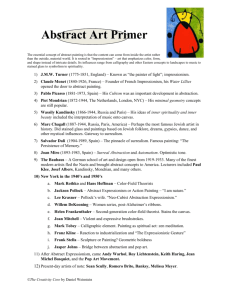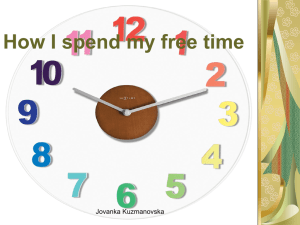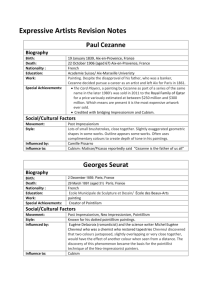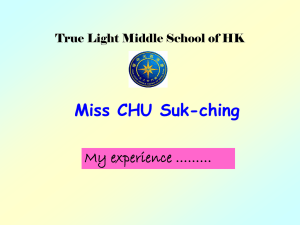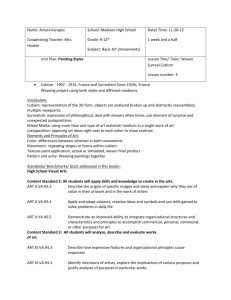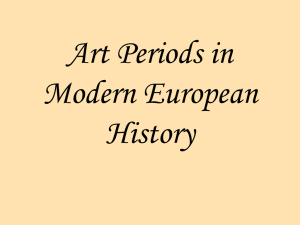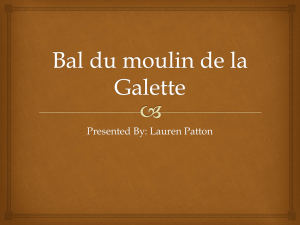here - Northwestern University
advertisement
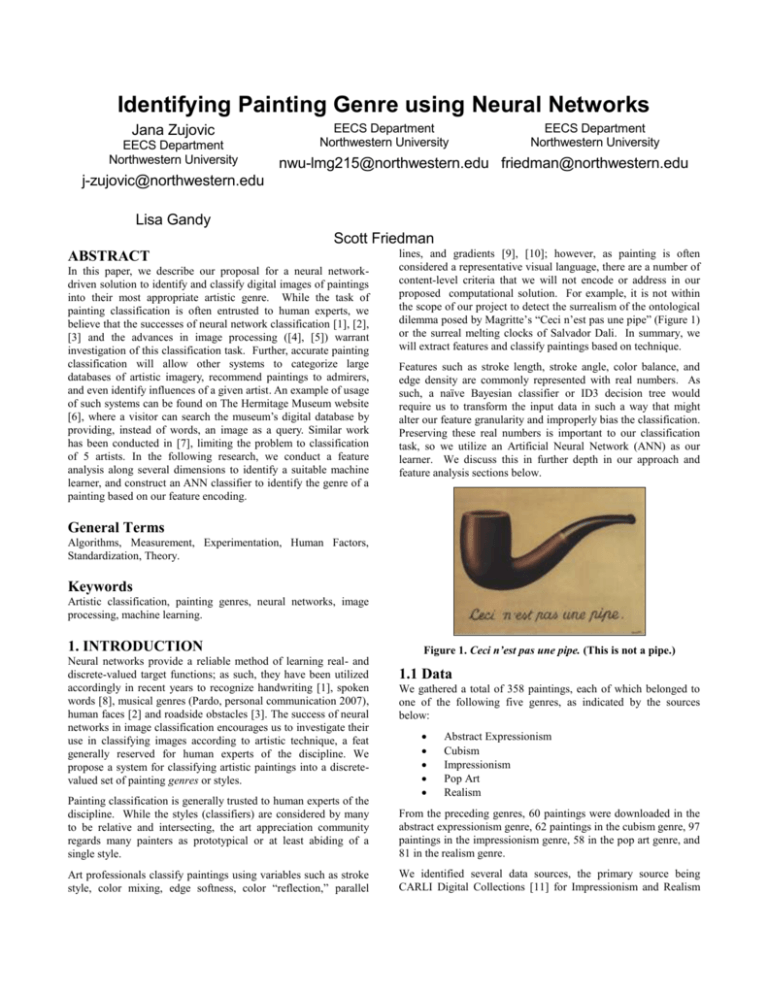
Identifying Painting Genre using Neural Networks Jana Zujovic EECS Department Northwestern University EECS Department Northwestern University EECS Department Northwestern University nwu-lmg215@northwestern.edu friedman@northwestern.edu j-zujovic@northwestern.edu Lisa Gandy Scott Friedman ABSTRACT In this paper, we describe our proposal for a neural networkdriven solution to identify and classify digital images of paintings into their most appropriate artistic genre. While the task of painting classification is often entrusted to human experts, we believe that the successes of neural network classification [1], [2], [3] and the advances in image processing ([4], [5]) warrant investigation of this classification task. Further, accurate painting classification will allow other systems to categorize large databases of artistic imagery, recommend paintings to admirers, and even identify influences of a given artist. An example of usage of such systems can be found on The Hermitage Museum website [6], where a visitor can search the museum’s digital database by providing, instead of words, an image as a query. Similar work has been conducted in [7], limiting the problem to classification of 5 artists. In the following research, we conduct a feature analysis along several dimensions to identify a suitable machine learner, and construct an ANN classifier to identify the genre of a painting based on our feature encoding. lines, and gradients [9], [10]; however, as painting is often considered a representative visual language, there are a number of content-level criteria that we will not encode or address in our proposed computational solution. For example, it is not within the scope of our project to detect the surrealism of the ontological dilemma posed by Magritte’s “Ceci n’est pas une pipe” (Figure 1) or the surreal melting clocks of Salvador Dali. In summary, we will extract features and classify paintings based on technique. Features such as stroke length, stroke angle, color balance, and edge density are commonly represented with real numbers. As such, a naïve Bayesian classifier or ID3 decision tree would require us to transform the input data in such a way that might alter our feature granularity and improperly bias the classification. Preserving these real numbers is important to our classification task, so we utilize an Artificial Neural Network (ANN) as our learner. We discuss this in further depth in our approach and feature analysis sections below. General Terms Algorithms, Measurement, Experimentation, Human Factors, Standardization, Theory. Keywords Artistic classification, painting genres, neural networks, image processing, machine learning. 1. INTRODUCTION Neural networks provide a reliable method of learning real- and discrete-valued target functions; as such, they have been utilized accordingly in recent years to recognize handwriting [1], spoken words [8], musical genres (Pardo, personal communication 2007), human faces [2] and roadside obstacles [3]. The success of neural networks in image classification encourages us to investigate their use in classifying images according to artistic technique, a feat generally reserved for human experts of the discipline. We propose a system for classifying artistic paintings into a discretevalued set of painting genres or styles. Figure 1. Ceci n’est pas une pipe. (This is not a pipe.) 1.1 Data We gathered a total of 358 paintings, each of which belonged to one of the following five genres, as indicated by the sources below: Abstract Expressionism Cubism Impressionism Pop Art Realism Painting classification is generally trusted to human experts of the discipline. While the styles (classifiers) are considered by many to be relative and intersecting, the art appreciation community regards many painters as prototypical or at least abiding of a single style. From the preceding genres, 60 paintings were downloaded in the abstract expressionism genre, 62 paintings in the cubism genre, 97 paintings in the impressionism genre, 58 in the pop art genre, and 81 in the realism genre. Art professionals classify paintings using variables such as stroke style, color mixing, edge softness, color “reflection,” parallel We identified several data sources, the primary source being CARLI Digital Collections [11] for Impressionism and Realism genres, and Artlex [12] for the remainder of the genres. In addition, as the examples of paintings for Abstract Expressionism, Cubism, and Pop Art were relatively small within the above sources, a Google image search [13] of paintings related to genretypical painters for the lacking genres. We utilized ArtCyclopedia [14] to validate important painters' names in each genre. In post-processing of the downloaded data, we removed any existing picture frames which were part of some of the images, as these are artifacts of the presentation context and are not representative of the painting genre. An immediate concern upon viewing the data was the variation in resolution: much of our Impressionism and Realism data collected from the CARLI digital collections exceeds 15Mb per image, whereas the resolutions of images in other genres rarely exceed 500Kb. Though we planned to normalize all of our features by the size of the image, we identified an issue that feature-scaling would not remedy: texture. # histogram bins x number of paintings. To get a high-level idea on how would the simple classifier work, based only on this one feature, we averaged the value for each bin over the number of paintings so that the dimensions became # histogram bins x 1 for each artistic genre. Since the number of histogram bins per feature was very large we then reduced the total number of histograms bins by taking the average of the frequencies over a certain number of bins. For example the RGB feature initially had 4913 bins and this was reduced to 10 by taking the average frequency over 500 bins and reducing this to 1. The 4913 points initially extracted for the RGB (Red, Green, Blue) histograms quantize the pixels of the image into discrete color bins, scaled by the total number of pixels, so that the points represent the percentage of pixels in the painting having a certain RGB value. This was necessary, given the images we collected were of different sizes and we needed to make color histograms comparable. 0.3 Abstract Expressionism Cubism 0.25 Impressionism 0.35 0.2 Pop Art 0.15 Realism 0.1 0.05 Texture, available only at higher resolutions, reveals the thickness and gloss of the paint (see Figure 2, left half) and subtle striations of the canvas (see Figure 2, lower right). Instead of discussing texture further, it suffices to say that because texture visibility is a factor of resolution, we normalized image resolution prior to feature extraction. We scaled high-resolution paintings down opposed to scaling low-resolution paintings up, as up-scaling would only pixelate the image instead of normalizing the texture. 2. APPROACH The majority of our work was spent analyzing the features to determine which supervised learning paradigm best fits this classification problem. If it so happens that we can classify the data utilizing only one extracted feature, by a naïve quantity range analysis, an ANN solution is not the right tool for the problem. For this purpose, we include an in-depth feature analysis to show that we can utilize multiple extracted features to yield more robust classification. After analyzing the extracted features and deciding that an ANN solution was the best learner for the problem, we reviewed several ANN packages and decided on EasyNN, a freely-available software package. 2.1 Feature Extraction and Analysis We used MatLab to extract features from the paintings. The data was originally extracted per each feature per each artistic genre. Initially, extracting the feature RGB would result in five excel files (one per genre) where the dimensions of each excel file were 0 50 0 10 00 15 00 20 00 25 00 30 0 35 0 00 40 00 45 0 49 0 14 Figure 2. Texture of high-resolution Impressionism Figure 3. RGB histograms across genres In Figure 3 (which shows bins reduced from 4913 discrete bins to 10 as discussed previously), the RGB data does exhibit nonuniform behavior at first glance, but we can, however, identify several points of interest: the high percentage of darker reds (bin #2) in realism, the abundant use of brighter reds and mid-tone greens (bins 3-6) in impressionism, and the use of white (bin #9) in pop art. On this dimension, Abstract Expressionism and Cubism are very closely related. 0.3 8 7 0.25 6 Cubism Impressionism 0.15 Pop Art 0.1 V arianc e Abstrac t Expressionism 0.2 4 A bs . E xp. C ubis m 3 Imp. 2 P op A rt 5 Realism R ealis m 1 0.05 0 1 2 3 4 5 6 7 8 9 10 11 12 13 14 15 16 0 32 64 96 128 160 192 224 255 Figure 4. Value (V) histograms across genres HSV (Hue, Saturation, Value) features were also extracted, which were also converted into histograms. The color data varied between genres most radically in the Value (lightness) dimension (see Figure 4), but very little in the Hue and Saturation dimensions, so we do not present the latter two below. The Value dimension looks more promising in that the discrepancies across genre averages are more pronounced; however, the cubism and abstract expressionism dimensions are still closely correlated. Next, we extracted and analyzed edge densities, which quantize the frequency of color boundaries. We extracted the edge data using Canny edge detector at several thresholds: 0.2, 0.3, 0.4, and 0.6 (see Figure 5 below). As the threshold increases, the algorithm is more conservative about which color boundaries it should report as an edge. Our findings are similar in that abstract expressionism and cubism are similar along this dimension, but pop art correlates closely with these genres. G a bor wa ve le t orie nta tion/sc a le Figure 6. Gabor Wavelet histograms across genres Finally, we processed the images with Gabor filters, with 4 different scales and 4 orientations (0°, 90°, 45°, -45°). Gabor filters are known for capturing well texture features of images [15]. The implementation of the filters is taken from [16], which represents each painting with a 32-point-long feature vector – for each combination of the scale and orientation; we have the mean and the variance of the energy content of the image. As we can see in Figure 6, Cubism and Abstract Expressionism are almost indistinguishable along this feature as well. Based on the above analysis, we predict that realism, impressionism, and pop art each have sufficient differences along at least one dimension to suggest positive classification of the three genres by an ANN. We expect our ANN may falsely classify cubism as abstract expressionism, and the reverse. 2.2 Learner After evaluating several ANN packages, we chose to work with the EasyNN package, a third-party software program. Per our data analysis, we use Value (brightness), Gabor-variance (stroke data) and edge density data for classification, which results in a total of 28 input nodes (see Figure 7). Figure 5. Edge Threshold histograms across genres Figure 7. Custom ANN topology Our ANN contains five outputs - one for each target genre. We began our experiments using floating-point outputs and intended to perform numerical analysis to determine the maximum output, but later switched to Boolean outputs once we realized that our ANN package could automate this analysis. For the following experiments, we configured our learner with a hidden layer of eight nodes, a learning rate of 0.7 (decay-enabled) and a momentum of 0.8 (also decay-enabled). 2.3 Training and Testing We partitioned the data into five sets of about 70 paintings each. We then performed K-fold cross-validation, whereby we trained with four of the five sets and tested with the fifth. All of our training sessions lasted roughly 10,000 cycles, and the rest of the training/testing variables we held constant. Additionally, to provide another dimension of analysis, we removed the two more difficult genres (Abstract Expressionism and Cubism, as identified in our Feature Analysis section) for a simplified scenario and re-ran the experiments. 3. RESULTS The most naïve classifier to this problem would choose Impressionism every time, as Impressionism is our largest target genre, at 97 of 358 data points. This would result in classifying with 97/358 = 27% accuracy. With Cubism and Abstract Expressionism removed (our simplified scenario), this would result in 97/236 = 40% accuracy. The overall ANN results for five genres and three genres are below in Figure 8 and 9 respectively. We computed these results by training and testing five times, per our K-fold cross-validation strategy, above. We then computed the accuracy overall, and on a per-genre basis. 4. SUMMARY & FUTURE WORK The experiments and data analyses in this research investigated a machine learning solution to painting classification. Our feature analysis helped us to identify dimensions in the data that aided classification, from which we concluded that an ANN would suit the learning problem best. Our initial feature analysis also yielded the foresight that two of the five genres would prove difficult to classify, which we validated with our ANN output. Our ANN classifier performed at 55% accuracy for five artistic genres, based on brightness, edge density, and Gabor filter encoding, which outperformed a naïve pick-the-most-probableclassifier strategy two-fold. In our simplified scenario, we achieved 71% classification accuracy, which is much better than the 40% naïve classification accuracy. Though the results demonstrate that a machine can indeed differentiate painting genres to some degree, it is highly possible that extracting more features from these paintings (i.e. geometric analysis, line curvature) could prove fruitful and improve upon the classification system we have discussed herein. 5.RELATED WORK As mentioned in our introduction, ANN solutions are utilized in face recognition (Cottrell, 1990), handwriting recognition (Lecun et al, 1989), and even observing roadside conditions for robot driving (Pomerlau, 1993). Recent work in image processing has classified images as spam (Gao, Yang, Zhao, 2007) with other learning algorithms, and others have classified images by extracting histograms and utilizing support vector machines (Chapelle et al., 1999). 6. ACKNOWLEDGMENTS Thanks to Bryan Pardo for advising us with regards to validation, encoding, and pre-training feature examination. 7. REFERENCES [1] Lecun, Y., Boser, B., Denker, J. S., Henderson, D., Howard, R. E., Hubbard, W., & Jackel, L.D. (1989). BACKPROPAGATION applied to handwritten zip code recognition. Neural Computation, 1(4). [2] Cottrell, G. W. (1990). Extracting features from faces using compression networks: Face, identity, emotion, and gender recognition using holons. In D. Touretzky (Ed.), Connection Models: Proceedings of the 1990 Summer School. San Mateo, CA: Morgan Kaufmann. Figure 8. ANN testing results for all five genres. We see from Figure 8 that the ANN overall accuracy was 55%, which outperformed the most naïve classification strategy, as discussed above, by two-fold. When Abstract Expressionism and Cubism are removed, we achieve 71% accuracy, which is a substantial improvement over the 40% accuracy of the simplified naïve strategy. The three-genre learner also classifies Pop Art at 88% accuracy. From the above results we find that the conclusions drawn in our data analysis section proved true – Abstract Expressionism and Cubism are the most difficult to classify, and removing them improves our accuracy. [3] Pomerleau, D. A. (1993). Knowledge-based training of artificial neural networks for autonomous robot driving. In J. Connell & S. Mahadevan (Eds.), Robot Learning (pp. 1943). Boston: Kluwer Academic Publishers. [4] Gao, Y., Yang, M., Zhao, X. (2007). Image Spam Hunter. EECS 349 Final Project. Winter 2007 [5] Chapelle, O., Haffner, P., Vapnik, P.M. (1999). Support Vector Machines for Histogram-based Image Classification [6] The Hermitage Museum, www.hermitagemuseum.org [7] Seldin, Y., Starik, S., Werman, M. (2003). Unsupervised Clustering of Images using their Joint Segmentation. [8] Lang, K. J., Waibel, A. H., & Hinton, G. E. (1990). A timedelay neural network architecture for isolated word recognition. Neural Networks, 3, 33-43. [9] Healey, C. (2001). Formalizing Artistic Techniques and Scientific visualization for Painted Renditions of Complex Information Spaces. In IJCAI Proceedings 2001. [10] Wikipedia contributors (2007). Impressionism. In Wikipedia, The Free Encyclopedia. Retrieved November 31, 2007. http://en.wikipedia.org/wiki/Impressionism. [11] CARLI digital collections.http://collections.carli.illinois.edu/ [12] Artlex Art Dictionary. http://www.artlex.com [13] Google Image Search. http://images.google.com/ [14] ArtCyclopedia. http://www.artcyclopedia.com [15] Deac, A., van der Lubbe, J., Backer, E. (2006). Feature Selection for Paintings Classification by Optimal Tree Pruning. In Multimedia Content Representation, Classification and Security (pp. 354-361). Springer Berlin / Heidelberg. [16] D.Zhang et al., Content-based Image Retrieval Using Gabor Texture Feature [17] Mitchell, T. (1997). Machine Learning (pp. 112-113). McGraw-Hill.

